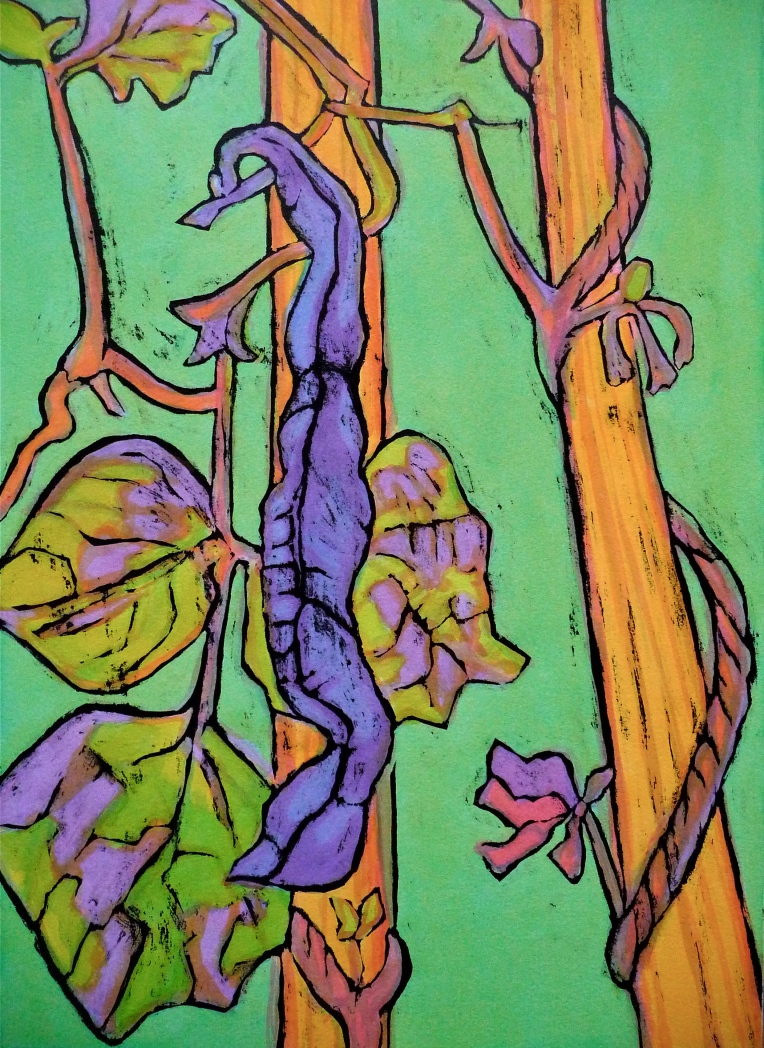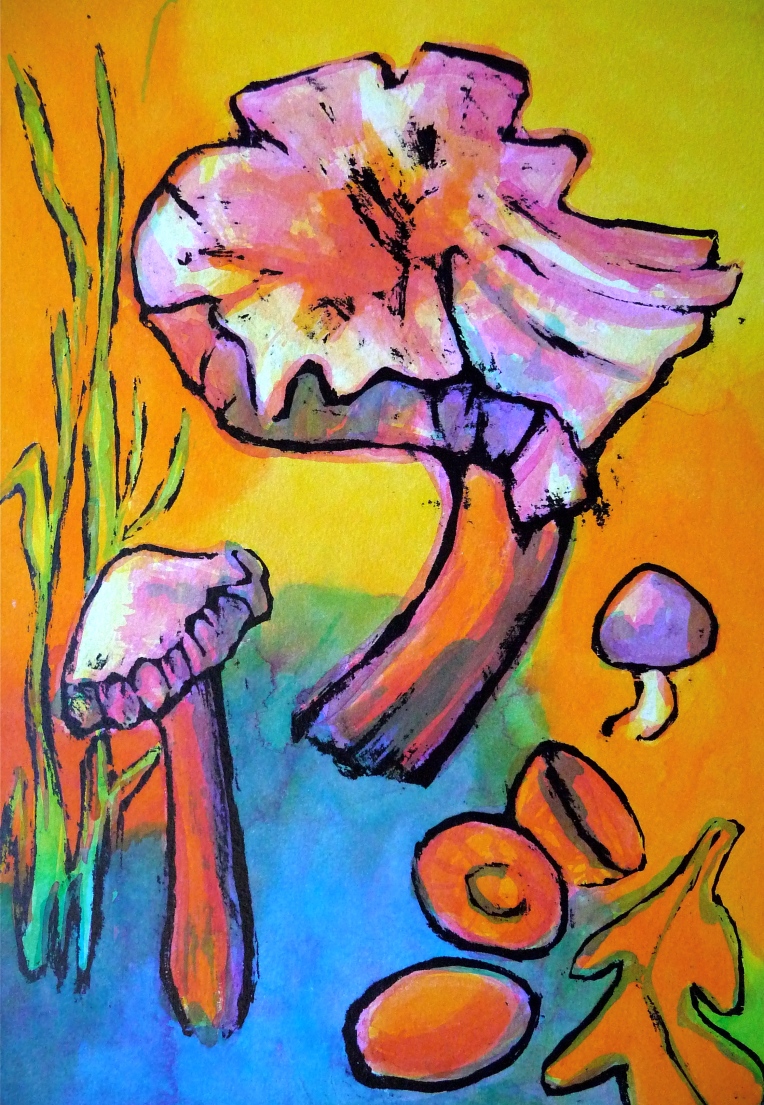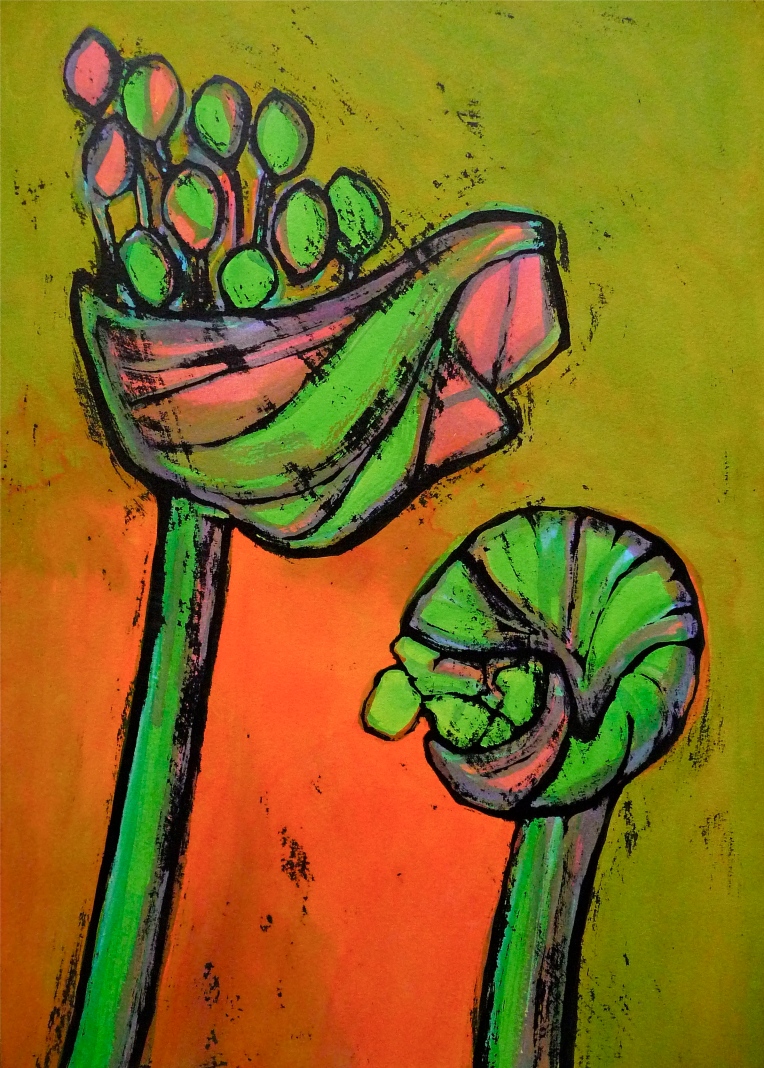When I am clearing the last of the summer produce from the vegetable patch I leave the french and runner beans hanging for a few weeks longer. The ripened seeds are dried off, so they do not go mouldy, and stored ready for sowing next spring. As the pod contracts and expands it takes on a different form, easy to overlook as often hidden behind curling leaves, but if noticed it is a good subject to add to the sketchbook.
‘Purple bean podding’ is an ink painting, acrylic and indian, worked up from an oil pastel sketch.
PS I do not know the true name of this bean but I call it Purplette.
Month: November 2013
Winter vine arch – Dedham Vale Vineyard – Jenny Hill
The past few days have been taken up with making frames, cutting mounts, buying glass and putting it all together, making sure labels have the correct information. A short notice opportunity for exhibiting artwork at Dedham Vale Vineyard 30th November – 1st December, made me put aside creativity and focus on the presentation. It’s a distraction but in truth for me, it makes sense financially, time wise and patience, to do my framing a few at a time. To have work ready for small exhibitions is a bonus and also it gathers work long term for a solo exhibition Spring 2014, (lots of space, great! or could that be aargh! lots of space – more work to be done). Getting an idea as to how the paintings will look as a group instead of stored in the plan chest drawer is a reality check worth doing sooner than later.
Grey sky, gloomy light, rain, conspired to increase the vibrancy of the autumn leaf colour – a beautiful day if you do not have to work in the fields.
Information for Dedham Vale Vineyard, (Constable country) please visit
http://www.dedhamvalevineyard.com/
Vine – small fruit – Ink – Jenny Hill
Last year a friend took down lengths of vine that she had used in an installation of contemporary floral design and paintings at Chelmsford Central Library. At the end of the exhibition and no sales, I had a very large canvas painting to wrap and pack in my car, parked on a busy road, traffic wardens around to give parking fines if they thought you were taking too long. But the bag of discarded vine cuttings came with me. All rooted, grew rapidly, (bit rampant), and this one fruited. Small grapes even when ripe but the birds liked them. ‘Brant’ is a decorative vine , grown for it autumn colour.
‘Vine – small fruit’ is an ink painting worked up from an oil pastel sketch.
Fungi – Fly Agaric – Jenny Hill
Fungi – Fly Agaric – Amanita muscaria, found on Tiptree Heath in a clearing between Birch and Oak trees. Heavy rain can wash off the white fluffy spots, (veil), leaving a red fungi surrounded by white fluff dots on the grass. Before the mature fungi collapses, no longer red, it flattens out, curling upward.
My ink painting “Fungi – Fly Agaric” presented a challenge – how to show the fluff dots sitting on the surface and not as flat white marks.
Fungi with bramble and heather – Jenny Hill
On the heathland there are wooded areas and clearings where gorse and heather grow. It was out, away from the oak and birch trees, I found the hat shaped fungi, looped over with low growing bramble.
“Fungi with bramble and heather”, acrylic ink and india ink on watercolour paper. One in a series of paintings of plant forms, fruit and seed heads. I prefer to work on groups of paintings, each connected to the other by subject matter or ideas and from my own experience.
Fungi and acorn – Ink painting – Jenny Hill
A photograph taken on a fungi hunt was used for an oil pastel sketch, which was then reworked for my ink painting – ‘Fungi and acorn’.
Exmoor ponies are now kept on Tiptree Heath to help maintain the balance of plants and growth specific to heathland. 2013 has been described as a ‘mast year’ for England – heavy crops of nuts and fruit. This is evident on the heath where the bumper crop of acorns are cleared from areas grazed by the ponies, limiting the amount of nuts eaten.
Reference for mast years visit
http://www.forestry.gov.uk/newsrele.nsf/AllByUNID/CA9C50439BE651A980257BD000474590
Sketch books – Ian Hay – Digby Gallery, Mercury Theatre, Colchester, Essex
Seen last week an exhibition of new artwork, small oil paintings and large charcoal drawings by Ian Hay. “A mile from the Mercury” continues until 9th November at the Digby Gallery, Mercury Theatre, Colchester.
I chose to post a photograph of two sketch books accompanying the exhibition as it can offer an insight to an artists creative process. Ian Hay was tutor for drawing at Colchester Institute when I was a student of visual studies for two years and our small student group had a lot of fun, regular life drawing and drawing outings. Useful preparation for when I went on for further studies at Ipswich Art School.
Artwork can be see at
http://www.mercurytheatre.co.uk/your-visit/digby-gallery/
A biography
http://www.debretts.com/people/biographies/browse/h/9065/Ian%20Wood+HAY.aspx
Fungi on oak twig – Jenny Hill – acrylic ink, indian ink
My seasonal studies continue after I went on a fungi hunt at Tiptree Heath organized by the Essex Wildlife Trust and supervised by a Mycologist from Colchester Natural History Museum. Approximately twenty people searched the heathland and in two hours collected 50 different fungi. Of these only a handful are good to eat, a few more are edible (would not make you ill), but some are highly toxic.
With very little time to draw I took photographs for reference. I find working from a print out of the photograph restricts my preferred way of working so I make quick sketches from the image on my computer, using pens or oil pastels. This approximates to drawings made outside and is my starting point for further development into an ink painting.
Essex Wildlife Trust
http://www.essexwt.org.uk/
Colchester and Ipswich Museums
http://www.cimuseums.org.uk/home.html
Plant form – Agapanthus no.2 – Jenny Hill
Agapanthus plant form – individual flower heads emerging from the bud.
Agapanthus no.2 is an ink painting developed from a sketchbook study. I draw with colour in my sketchbooks as it is another responsive element for expression of light, weather, heat, colour of the subject or my energy. I use the black ink in the paintings as a network, loosely overlaying the colour beneath, defining the form.








